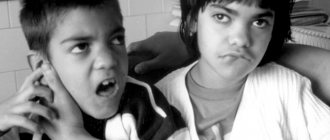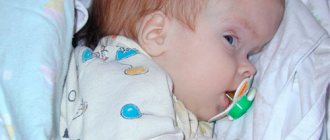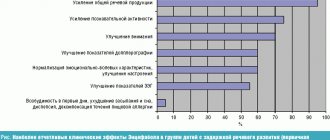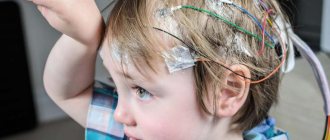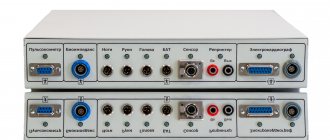Mental retardation (oligophrenia) is an acquired or congenital underdevelopment of the psyche and intellect, formed due to brain pathology and accompanied by social maladjustment. In addition to insufficient development of the cognitive sphere (intelligence, thinking, attention, speech and memory), behavior, motor skills and segments of the psyche responsible for emotions and volition also suffer.
The terms “mental retardation” (hereinafter referred to as MR) and “mental retardation” should not be confused. If a child has so-called “pedagogical neglect,” then we are talking about mental developmental development, and not about educational attainment. Also, mental retardation should be distinguished from dementia. LD implies a congenital or acquired mental defect before the age of 3, in which intelligence indicators are reduced. Dementia is a disorder in which intelligence, for some reason (illness or injury), decreases from normal levels (for example, in older people with Alzheimer's disease).
Causes of mental retardation in children
- Heredity and genetic diseases (for example, Down syndrome);
- Incompatibility of the fetus and mother according to the Rh factor;
- Injuries to the baby during childbirth or obstetric procedures (asphyxia, hypoxia, birth trauma), prematurity;
- Intrauterine pathologies of the fetus of various origins;
- Injuries and diseases of the central nervous system at an early age.
Degrees of mental retardation
Traditionally, the degree of MR was classified according to the severity of the defect (from mild to severe): debility, imbecility, idiocy. However, these days, terms that have been familiar for many years are excluded from the international classification of diseases due to the fact that these words have become used in an offensive sense and leave a negative imprint on the perception of people with such a disorder.
The modern classification of educational degrees is as follows:
| Traditional term | Modern classification and heading in the International Classification of Diseases |
| Moronism | Light UO (F70) |
| Mild imbecility | Moderate SV (F71) |
| Marked imbecility | Heavy UO (F72) |
| Idiocy | Deep UO (F73) |
IQ is determined using standard tests, taking into account the cultural characteristics of the child, by a special commission.
Causes of the disease
- damage to the fetus in the mother's womb by neurotoxic factors of an infectious, chemical, physical nature - syphilis, cytomegalovirus, ionizing radiation and others;
- the birth of a baby before a certain time is a major prematurity;
- disruptions during the birth process, as a result of which the baby could receive a birth injury or temporary asphyxia was observed;
- receiving serious head injuries in early childhood;
- brain hypoxia;
- infectious diseases that resulted in damage to the child’s central nervous system;
- living in dysfunctional families and, as a consequence, pedagogical neglect;
- manifestation of dementia of unknown etiology.
Clinical picture of oligophrenia
There are three key diagnostic criteria for MR:
- Clinical - brain damage;
- Psychological - persistent impairment in the cognitive sphere of the psyche;
- Pedagogical - reduced learning ability.
The leading symptom of mental retardation is poor cognitive activity in the child. In infancy, it can be observed that the child lags behind the norm in terms of motor and psychomotor development. Starts to sit, crawl, and walk late. Interest in the outside world is reduced, as is the need to communicate with adults. The baby does not reach for toys, does not grab them, does not try to manipulate them. At an older age, as a rule, speech delay, misunderstanding of addressed speech, misunderstanding of instructions, instability of attention, and lack of desire and ability to communicate with peers are also revealed. The game's development is still lagging. And if peers at 3-4 years old are already actively playing, imitating adults, they have role-playing games, then children with mental retardation at this age demonstrate object-based play, basic manipulation of a toy, without a plot. Also a characteristic sign of PD is poor development of motor skills, motor clumsiness, and a low level of graphic and visual skills. Before school age, drawing is often developed at the level of sketching. It is difficult for such children to learn to tie shoelaces, fasten buttons, and so on. Sensory development, perception of information, stability of voluntary attention are impaired, mental operations are not fully formed. In order for a child to learn any information, he needs more vivid stimuli, a more detailed division of information and a greater number of repetitions, as well as a clear, substantive illustration of the material. It takes a longer time to assimilate a certain amount of material (compared to the norm). Even at school age, children with ID are not able to operate with abstract information and must, in order to assimilate, relate the information received to a specific, objective example. In addition to the cognitive sphere, they also note the pronounced originality of the emotional-volitional and behavioral sphere. These symptoms in their manifestation depend on the social environment, the degree of retardation, the depth and localization of organic brain damage. Since in mental retardation there is always an “organic soil” present, the nature of the brain damage leaves its mark on the external manifestation of the disorder. That is, the location of the lesion and its features can “add” certain qualities to the child, for example, difficulties in orientation in space and time, lethargy, irritability or aggressiveness, emotional inhibition, inertia, or vice versa, frequent mood swings, hysteria, capriciousness, excitability. What these children have in common in the emotional-volitional sphere are: emotional immaturity, dependence on adults, impressionability, suggestibility, lack of independence, lack of initiative, difficulty in assimilating social norms, which leads to maladjustment. In some cases, mental retardation is combined with other diseases and disorders, which complicate the overall picture and complicate diagnosis and prognosis. For example, there are children with hearing or vision impairments.
The clinical picture varies greatly depending on the degree of MU: Deep MU - children do not study in kindergarten and school, often do not speak, and are not capable of self-care; sometimes non-ambulatory. They live in families or special institutions (with parental consent). Their world is limited to satisfying physical needs. They make inarticulate sounds and often have the habit of self-sickness (swinging from side to side). Children with severe disabilities also do not attend kindergartens and schools and may live in specialized institutions. They need the help of a defectologist (oligophrenopedagogue) in mastering basic speech and self-care skills. Learning abilities are minimal, but they are there. They can repeat stereotypical actions according to a model. Moderate personality disorder - according to the old classification, this is not pronounced imbecility. For such children, schooling is also not provided, but their learning ability is noticeably higher. They can master simple phrasal speech with defectological support and regular classes. Capable of simple self-service and basic work. Mild mental illness is the most common type of mental retardation today (70-90% of all cases). Such children are teachable; a specialized (correctional) school of the VIII type is provided for them. The main task of education is to master reading, writing, counting, to obtain the necessary knowledge and work skills to adapt to the outside world - everything so that a person can socially adapt in adulthood. Upon completion of training, the graduate, unfortunately, will not be able to go to study at a university; this path is closed.
DIAGNOSTIC CRITERIA
According to DSM-5 (the fifth edition of the Diagnostic and Statistical Manual of Mental Disorders), intellectual disability is a neurodevelopmental disorder, characterized and defined by the following symptoms:
- Deficits in intellectual functioning. Difficulties with abstract thinking, reasoning, decision making, and learning. All this must be confirmed by appropriate tests.
- Deficit of adaptive behavior. Inconsistency with accepted cultural and social standards, inability to live independently, reduced social responsibility, difficulties with communication. That is, the individual cannot communicate and serve himself and needs care wherever he is.
- A person finds it difficult to perform tasks that require memory, attention, speech, writing, reading, mathematical reasoning, and is unable to gain practical skills.
- Problems in the social sphere. Does not have socialization skills - communication with people, cannot make friends and maintain relationships. Doesn't understand his feelings and thoughts.
- Problems in the practical field. Poor ability to learn skills, lack of control over one’s own behavior, inability to take care of oneself, irresponsibility, etc.
Other signs
Together with the mentioned criteria, the presence of any stage of CP can be determined by the following criteria.
In the primary period of development, a healthy child masters simple skills, which, as they grow older, are well mastered and move on to more complex ones. Adaptive and intellectual problems become noticeable as the child develops. When they appear depends on the type, cause and degree of mental retardation.
The stages of development (motor skills, speech, socialization) of children with intellectual disabilities are the same as those of healthy people, but they progress much more slowly, that is, they reach a certain level much later. With a mild form of mental retardation, the lag behind peers becomes noticeable only at the beginning of school (learning difficulties), and with a severe form - in the first years of life.
As a rule, if intellectual disability is inherited (by genes), it affects the person’s appearance.
Oligophrenics are more likely to have physical, neurological and other health problems. For such individuals, sleep disturbances, anxiety disorders, and schizophrenia are also common. Diabetes, obesity, sexually transmitted diseases, and epilepsy are common.
People with mild to moderate intellectual disabilities speak much less well than their younger peers. The higher the level of disorder, the worse the speech.
Behavioral disorders characteristic of oligophrenics are associated with the discomfort they experience when communicating, the inability to communicate their thoughts to others, and a misunderstanding of their desires and needs. In addition, they suffer from social isolation. This is where manifestations of excitement, anxiety, nervousness, etc. follow.
Education program for children with mental retardation. Diagnosis, correction and prognosis
Modern medicine and pedagogy do not stand still. Developmental delays in children are now diagnosed very accurately and at an earlier age than before. As early as a year and a half, if there is a suspicion that the baby is behind the norm, parents have the opportunity to conduct a full diagnosis and begin early correction to prevent the worsening of the defect and compensate for it. Today, so-called “borderline” forms of disorders are widespread, when a child has neurological, organic disorders, but does not have a severe defect. For them, the prognosis is most favorable, since with timely treatment by a neurologist and regular classes with a defectologist (oligophrenopedagogist) and speech therapist, the consequences of the disorder can be minimized and compensated. In some cases, a child with mild mental retardation can even go to a general education school (with inclusion or a specialized class), but more often a special commission recommends a special school. In the lower grades, there is the possibility of transferring to a regular school (however, for mentally retarded children, this opportunity still implies training in a specialized class). The correctional school does not issue a certificate, but only a certificate of participation in the educational process. There, students do not stay for a second year, that is, they learn the material to the best of their ability without a mandatory “bar.” With an issued certificate of study, graduates can go to a vocational school or evening school. Some schools have 10th and 11th grades, in which the emphasis is on labor training and mastering a profession. In successful training, the student is assigned a rank or qualification. For children with moderate and severe mental retardation today there are more opportunities in terms of correction and development than before. According to reports from defectologists, such children, despite the generally accepted opinion, are still able to go to a special correctional school (a school for mildly mentally retarded children) as part of a special class. If there are about 12 children in a regular correctional school class, then there should be no more than 8 children in such a class.
In addition to the direct intelligence indicator, to predict the development of a child with ID, it is extremely important to take into account the characteristics of the emotional-volitional sphere and behavior. With an uncomplicated picture, when it is possible to build communication with the child, motivate him to study, and adapt him to the pedagogical process, the prognosis is favorable. Such children are successfully educated and, with a mild degree of oligophrenia, already in adolescence adapt to society, are sensitive to the assessment of their personality and are able to build interpersonal relationships, for example, in their team. Graduates of schools with an easy degree of educational attainment are able to master a profession and find employment.
Defectologists emphasize that with a general diagnosis of “mental retardation,” an individual approach is important - both in matters of diagnosis and in correction, training, and education. Since such children can be very different, the pedagogical approach should be different each time. It is important for parents not to waste time and to see the opportunities and potential of the child for development. Conduct classes on the development of speech, motor skills, perception, thinking, attention, memory - all cognitive functions, as well as teach social and everyday skills, correct behavioral characteristics and have the maximum influence on the harmonization of the individual. At the Ember center, speech therapists and special educators, as well as special psychologists, conduct individual lessons with children diagnosed with mental retardation, successfully completing all of the above tasks.
Inclusion and special education Our society is developing, it is becoming more tolerant of people with psychophysical disabilities. We are moving away from stigmatization and denial of the problem of having children with special needs and are moving towards acceptance and maximum socialization of all members of society. The special education system in our country provides for the presence of correctional kindergartens and schools according to the type of defect (vision, hearing, mental disorders, speech problems, mental retardation, combined disorders). The complexity of the situation is that in such a system, children with special needs are forever separated into a separate group and almost completely lose the chance of full adaptation in society. There is a contrast between a healthy child and a child with special needs. And this stereotype continues to live in the minds of our fellow citizens, because it is reinforced by the pedagogical “machine”. Fortunately, this situation is changing, and our country is gradually moving towards the implementation of the idea of inclusive education, when children with special needs also study in a general education school, for example, attending an educational institution with a tutor (from the English tutor - mentor) - a special accompanying person. The advantages of this approach are obvious: the child’s potential is used to the maximum, without being limited by the reduced program of a correctional school. The child joins the team, and healthy children learn to accept various human manifestations. Such schools already exist in our country. However, implementing all the principles of inclusive education is labor-intensive: after all, children have different characteristics, and there is not always an objective opportunity to adjust the educational process for 1-2 children. Plus, a lot depends on the personality and desire of the parents, as well as their financial capabilities. For example, accompanying a tutor is quite expensive. Plus, in addition, parents, as a rule, hire a tutor and special education teacher to study at home, because the general school does not provide such support. Traditionally, children with disabilities still go to type VII or VIII correctional schools, depending on the manifestation of the defect. One of the advantages of a correctional school is that the child has maximum opportunities for easy adaptation, the program is easier to assimilate, and there is special support from special education teachers, speech therapists, psychologists, and doctors. Labor adaptation of the graduate is provided.
Activities for children with mental retardation
If there is a delay in the development of a child, it is extremely important to identify its cause and eliminate it and the resulting consequences as early as possible (if possible). At the beginning of the journey, parents of a child with mental retardation go through the diagnostic stage: doctors conduct a lot of examinations, including ultrasound of the brain, Doppler sonography, EEG and other examinations, depending on the source of the pathology. Sometimes the picture is complicated by other diseases, for example, hearing or vision impairment, or metabolic disorders. Of course, the earlier it was revealed that the baby is developmentally delayed, the greater the chances of successful compensation for the defect. So, it is extremely important to identify the leading cause, after which the attending physician (most often a neurologist) prescribes a correction strategy. It may be different from a medical point of view (depending on the origin of the defect), but all experts agree that educational and defectological methods play a leading role in correction. In the preschool period, it is important to make the most of the child’s potential, to involve a good speech therapist and defectologist in the classes so that the child gets as close to the norm in knowledge and skills as possible before reaching school age.
At the Ember center, work with children diagnosed with mental retardation begins with a consultation of specialists. A consultation is a comprehensive initial consultation of several specialized specialists: a defectologist (correctional teacher), a speech therapist, a special psychologist (or neuropsychologist). The composition of specialists may vary depending on the needs of the parents and the child. After a comprehensive consultation, specialists draw up a correction route, give their recommendations and conclusions to parents. Parents often come to our Center for such a consultation before the state commission (PMPC) to receive preliminary information and recommendations on which correctional path to choose (type of kindergarten, special school), and to understand the prognosis of the child’s development. As a rule, the correctional route includes classes for children with mental retardation with a defectologist, as well as with a speech therapist. Additionally, if necessary, an educational psychologist, a special psychologist or a neuropsychologist is involved in the work.
The lesson program includes:
- development of speech (for school-age children - also writing and reading), thinking, general and fine motor skills;
- elements of exercise therapy (included in classes with a defectologist);
- development of perception, improvement of attention, memory;
- correction of behavioral characteristics, emotional-volitional sphere;
- improving communication skills;
- Tomatis therapy;
- training in social and everyday skills, the ability to take care of oneself in everyday life.
If you wish, you can also purchase Forbrain and/or Soundsory devices for independent use at home.
